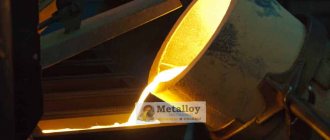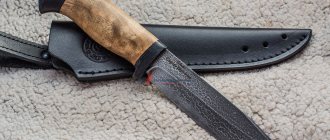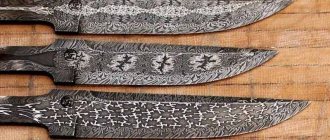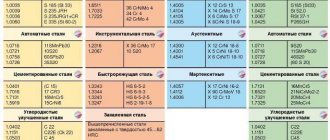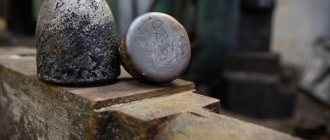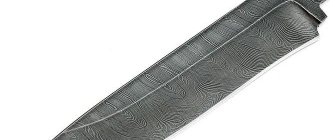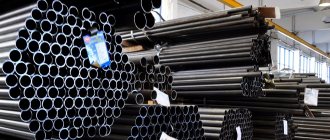How do you get damask steel?
Bulat can be obtained from some types of ordinary steel. The main condition is a low level of alloying of the material. It is impossible to obtain damask steel from high-alloy steel, and only low-quality damask steel from medium-alloy steel. Despite the fact that modern materials are superior to damask steel in their properties and do not require such complex processing procedures, there are still workshops in which enthusiasts make blades using ancient technologies. But the use of more modern tools makes it possible to smelt material of much higher quality.
In addition, many manufacturers are now adding additional elements to the alloy, which give damask steel new properties. This mainly concerns the use of chromium and nickel additives, which can significantly increase corrosion resistance. Some weapons, which are intended exclusively for collections and will not be used in staged battles, are completely covered with a layer of silver. This allows you to protect the steel from the negative effects of environmental factors. In addition, soft silver lends itself more easily to jewelry processing by applying thematic patterns or designs to the blade.
Damascus steel, unlike Damascus steel, which was also used for the production of blades, is characterized by a disorderly pattern. It is obtained as a result of crystallization of the metal lattice in the alloy.
A matter of national importance
In 1828, the government set the task: “At the Zlatoust arms factory, introduce the manufacture of sabers of equal quality to those made in Asia.” Soon the tsar was informed that “the best craftsman in Tiflis, Karamon Eliazaroshvili,” had pledged to reveal the “hereditary secret” he had received from his father Geurg (George) and “teach people to make weapons using this secret.” As a test, he made sabers and daggers from “real” (i.e. cast) and “in the manner of damask steel” (i.e. welding damask steel). At the same time, the master used both “Indian iron” and “Turkish steel”. “Turkish cast iron powder” is a traditional raw material that his ancestors dealt with in Erzurum. Thus, in 1833, the craftsmen of the Zlatoust state-owned factories were able to make weapons from welding damask steel, using iron and steel from domestic factories. “It is impossible not to recognize in Eliazaroshvili’s welding blades,” contemporaries responded, “a high dignity for sabers, which is proven by the very test often used on them, namely cutting off the head of a bull with one blow.” Eliazaroshvili himself received a thousand chervonets as a gift and was awarded a gold medal.
The Zlatoust plant was a metallurgical enterprise with a full cycle. The plant smelted cast iron from which hammers, anvils, wheels, cannonballs, bombs, weights, pots, pans and other household utensils were cast. In total, he produced 11 types of iron and steel.
Zlatoust dragoon officer's saber, model 1881
In 1812, a special white weapons factory was founded at the Zlatoust plant, which in 1816 sent the first batch of edged weapons along the Ai River. Soon Zlatoust became widely known for making mainly sabers of the “Damascus” type (welding damask steel). Ironically, these sabers were for some reason known as “Turkish”. In addition to sabers, the plant's weapons factory produced checkers, broadswords, sapper and high-quality hunting knives, which were famous far beyond the borders of Russia. However, tool steel was inferior in quality to English steel: cast steel was not yet produced at the plant.
Material production methods
There are four ways to make damask steel. The first involves direct fusion of iron ore with crushed graphite. This is the simplest method from a preparation point of view, since it does not require obtaining pure iron. But for its successful implementation, ore with a metal percentage of at least 85% is necessary, otherwise you will not get good quality damask steel.
Ores containing native sulfur, which are quite common in nature, are not suitable for this option. So getting the right material will be extremely difficult. In modern conditions, this method is not used, since finding pure iron is not a problem, but in ancient times this method was most common in blacksmithing. The second method involves melting iron with direct access to coal. In this case, not only pure carbon enters the alloy, but also its oxides, which give the metal the structure of damask steel. This method is also not used now, because it is characterized by a high proportion of impurities in the resulting material, which negatively affects its quality.
The third method is long-term burning of iron without air access. This method is the cheapest to implement and therefore is widely used. The material obtained in this way is called cast damask steel. An important condition for obtaining good material is accurate calculation of firing time. Otherwise, excess carbon may be introduced into the alloy, resulting in poor ductility and brittleness. The fourth option is the most expensive, but at the same time allows you to obtain the best quality material. It involves fusing pure iron with graphite in an airless environment. This allows you to rid damask steel of unwanted impurities and oxide additives.
Products made from damask steel of this brand are most valued among connoisseurs, so they are quite expensive. In ancient times, only wealthy warriors could afford such weapons. Nowadays, blades serve mainly as decorations that are hung on the wall. Occasionally, they can serve as historical reconstructions of famous battles of past eras. For the above purposes, the best quality damask steel is used so that the weapon looks beautiful and does not differ in its properties from the best blades of famous blacksmiths. The most expensive samples are decorated with a variety of hand-made patterns that are dedicated to the theme of battles. The handles of the blades also serve for decoration. They are made from a wide variety of materials, from skillfully crafted animal horns to precious metals. Additionally, the hilt can be inlaid with multi-colored stones.
The difference between crucible damask steel and cast steel
Now damask steel is produced using several technologies - the materials are generally identical, but they also have a number of differences:
- When producing a crucible alloy , iron ore, charcoal and a special flux are heated in special crucibles - smelting is performed in wood furnaces (compared to gas or electric furnaces, they do not provide such a high temperature). The technology is costly, but that's what makes blades for collectors.
- Products made from cast damask steel are simpler; they can be found at sales in Moscow. The raw material for steel is not iron ore, but special grades of low-carbon steel. It is easy to distinguish such damask steel - the pattern on the steel is not so pronounced , but the properties of the knives are practically the same.
Of course, the price of cast material is several times lower.
Damask steel blade.
Bulat and Damascus
Drawing of Damascus steel on a metal cut:
The term Damascus steel appeared relatively recently. A similar name for forged products began to appear in various sources in the middle of the 19th century. Before this, the name “Gurda” was more often used, as the creations of blacksmiths from the Caucasus and Mesopotamia were called. There they began to forge products from a mixture of alloys, achieving an unusual pattern on the surface of the blades.
Damask steel, as historical research shows, came from India. History museums have preserved samples of weapons that used alloy steel castings. Most often they contain chromium, the concentration of which can reach up to 14%.
However, damask steel production is designed only for individual production. Therefore, the technology is quite expensive. The master spends a lot of time to make a specific sample. If there is a conversation about mass production, then do not count on complex technology.
Metallurgist Pavel Petrovich Anosov studied production technology and created industrial technologies. The results of his work are present in all textbooks on metal science and blacksmithing.
Modern damask steel in products - a replica of the HP-40 knife in a modern design, made to order:
During the Great Patriotic War, the plant produced army knives and sabers for cavalry. Quite a lot of weapons have since been sold on various Internet resources. Modern blacksmiths produce remakes (this is the name for products that are made in the image and likeness of ancient samples). Several hundred workshops offer copies that are difficult to distinguish from the original.
Scout knife NR-40, made in 1942 - more than 7 million copies were produced:
Judging by the number of offers and prices, we can conclude that individual goods are in stable demand. The production of products from damask steel and Damascus steel can be quite an interesting and profitable business.
Modern knife HP-40, made according to samples from the period of the Great Patriotic War:
Experts see the difference between damask steel and Damascus steel in the raw materials:
- Damask steel is an alloy that contains a significant amount of alloying elements; during subsequent forging processing, platinum is connected using the forge welding method, which gives the product a complex of new properties.
- Damascus is a mechanical connection of metal blanks that differ in their properties. Forging up to several dozen layers is performed.
← Articles
RUSSIAN BULAT
Russian classic of metallurgy D.K. Chernov once said a coined phrase - “The best steel that has ever been produced in any country is, without a doubt, damask steel.” What is damask steel in its essence? The Russian classic of damask steel research, Pavel Petrovich Anosov, defined damask steel as “... steel having a patterned surface .” Nikolai Ivanovich Belyaev, a researcher of damask steel at the beginning of the 20th century, agrees with him with some clarification - “Bulk steel is called steel, the indispensable part of which is a pattern visible to the naked eye .”
Indeed, the damask pattern is visible to the naked eye and stands out in the form of light lines on a gray or black background after etching the product with some weak acid. The effect of the appearance of the pattern is explained by the sharp structural and chemical heterogeneity of the metal, in which areas with different carbon contents are etched and polished differently. Since ancient times, it was by the pattern that damask steel varieties were distinguished. Al-Kindi, an Arab weapons expert who lived in the 9th century, in the so-called. The Leiden Chronicle wrote that when looking at patterned steel, you see it both outside and inside. Indeed, by the appearance of a patterned blade alone, one can determine both the structure of the metal and the technology of its manufacture. And these technologies can be very different...
In a 12th-century treatise on weapons, compiled by the Armenian Al-Tarsusi specifically for Sultan Saladdin, it is said about patterned blade steel as follows: “ Bulat is the most powerful, the highest of all products . Its compositions are extremely varied and the processing varies depending on the composition.” It is this diversity of compositions and processing methods that has led to the fact that for a long time, even among experts, there was no consensus on which metal can be called damask steel and which cannot. This situation continues to this day, which sometimes leads to heated debate. It has been said that many disputes could be avoided if terms could be agreed upon, so I will present an abbreviated version of the modern classification, tailored to the topic of my message.
So. Patterned blade steels in Russia are usually distinguished mainly by the method of production and are divided into two large groups - Damascus and Damask steel .
Damascus includes all types of patterned, composite steels obtained by joining plates, fibers or granules of different chemical compositions using one or another version of diffusion welding . Such options include forge welding under a layer of flux, welding in an inert or reducing environment, diffusion welding in a vacuum, explosion welding, etc.
Damask steel steel itself , according to the peculiarities of production technology, is divided into three subgroups - namely:
1. Liquation or dendritic damask steel obtained by crystallization of a homogeneous melt
2. Patterned steels, in which sharp heterogeneity is formed as a result of special processing in the solid state. For example, by long-term annealing, as P.P. Anosov did in Zlatoust in the 19th century, by long-term high-temperature carburization, as Kathy Harnecker did at Henkels in the 20th century, or by directed complex TMT, which has become widespread recently.
3. And, finally, two-phase (solid-liquid) damask steel, which with good reason can be called Russian damask steel . Which, in fact, will be discussed further.
The first to point out the two-phase method for producing patterned steel was the Arab scientist Muhammad ibn Ahmedabu Reyhan al-Biruni, who in the 10th century wrote: “The steel produced in Herat comes in two grades: the first, when soft iron and cast iron are alloyed in a crucible. They are both connected in such a way that they are indistinguishable from one another and such steel is suitable for files and the like. The second grade is obtained when the specified substances melt unequally in the crucible and perfect mixing does not occur between them. Their individual particles are mixed up, but each of them is visible in a special shade. This is called the farand pattern and it is highly valued in swords.”
Some researchers are quite critical of this text as evidence of the incomplete melting of one of the components of the charge. They say that in ancient times metallurgists did not know the essence of the processes occurring during steel smelting, and the formation of patterns as a result of “incomplete mixing” of cast iron and iron should be understood as ordinary segregation processes.
One could agree with this, but the further words of Al-Biruni make it clear : “ In ancient swords, known as “al-Kuburiy”, sometimes thin veins remain that have not absorbed the cast iron. When they are caught on the blades, the swords are unable to cut due to lack of hardness. If these veins are cut off, then there is no harm.”
This, as far as I know, is the earliest description of a two-phase method for producing patterned steel, based on under-melting of part of the charge under relatively low-temperature smelting conditions in a cheese-blowing furnace. At the same time, in liquid, low-melting cast iron, solid particles of iron or low-carbon steel remain unmelted, which, upon subsequent forging of such a sharply heterogeneous ingot, form very large and clear patterns. Sometimes, as in al-Kuburi swords, ancient even for Al-Biruni, which today tend to be considered made in Yemen's Quburiya, the patterns turn out to be too large due to rough heterogeneity.
A description of an essentially similar method for producing blade steel can be found in China , where a similar metal was already produced in the 6th century directly in a furnace, melting thin iron rods and pig iron at a relatively low temperature, insufficient to melt iron and low-carbon steel . According to Sun Yingxing, the resulting roughly heterogeneous large alloy was unforged, chopped into pieces and melted again. A feature of the Chinese process, which was used back in the 17th century, is the repeated repetition of the melting-forging . The purpose of numerous meltings and forgings is quite obvious - the Chinese tried to refine the structure and even out the composition of the metal over the cross-section of the forging in order to avoid obtaining an overly rough, non-cutting “al-kuburi” blade.
The next most recent documentary evidence of two-phase smelting belongs to the director of the Anglo-Indian metallurgical company Cecil Schwerz , to whom Nikolai Timofeevich Belyaev . It was possible to find out that Schwerz is otherwise called Cecil Ritter von Schwartz (different sounds in English and German), and he gleaned information about the smelting of damask steel in India from the ancient treatise “Aini-Akbari,” “Akbar’s Administration,” written in the 16th century. 5th century Abul Fazl ibn Mubarak for Shah Akbar. In the second half of the 19th century, von Schwartz published a description of a method for producing damask steel, based not on the redistribution of secondary metallurgical products, iron and cast iron, but on the direct reduction of steel from iron ore.
According to this method, a mixture of small particles of two ores - brown and magnetic iron ore, namely three parts of magnetic iron ore (magnetite) and two parts of brown (limonite) - should be poured into the crucible along with charcoal and vitrified flux. Magnetic iron ore was extracted from waste rock immediately in the form of grains and flakes, and brown iron ore was specially crushed. Magnetic iron ore was mined in Kondapur, and brown iron ore was mined in Mirtapalli near Nirmala, in the vicinity of which the smelting took place, which lasted about a day.
The content and valency of iron in these ores was different, therefore iron was reduced from particles at different rates. As a result, the metal that was restored first during smelting managed to become heavily carbonized from contact with charcoal and melted, turning into cast iron, while the metal released from the more refractory ore remained less carbonaceous and therefore hard. The master needed to stop melting in time and fix the resulting sharply heterogeneous structure of the ingot. If you continue melting for some time, you will get a homogeneous melt.
In England, Indian damask steel was called “Wootz” and its ingots were brought from Golconda, as the regions of Central India were then called. It is interesting to note that the smelting of metal according to the process described by Schwartz took place in this area. Dr. Scott, who brought samples of Indian “Wootz” to England at the beginning of the 19th century, emphasized that “... this substance does not tolerate the slightest overheat due to its bright red color, because part of it begins to melt and the whole mass separates, as if it consists of two metals of varying degrees of fusibility .” Which, in fact, was what actually happened...
So, we can draw an intermediate conclusion. As has been shown, Al-Tarsusi's statements about the diversity of damask steel compositions turned out to be correct and in ancient times two-phase methods for the production of patterned steel were used consciously and purposefully for over a thousand years.
Now we must move from the ancient East to modern researchers of two-phase damask steel, but it is known that a scientific article is like a woman’s skirt - it should be long enough to be decent, but not too long so that readers do not lose interest. Therefore, further I will regretfully, but decisively, shorten my speech about researchers, briefly mentioning only the main milestones. And here, it must be noted, the undoubted leadership belongs to Russian scientists, which is why, in fact, I dared to call the composite obtained by the two-phase method “ Russian damask steel .”
Firstly, it is worth paying attention to one quote from P.P. Anosov from his journal of experiments from 1833, experiment 107, alloying of wound iron and graphite: “ When the crucible was cooled, the metal seemed imperfectly molten, because the shapes of pieces of iron were visible on the alloy, between which the graphite was contained, but the alloy was conveniently forged. At the lower end, patterns of a real “Khorasan” were discovered and a forging for the blade was pulled out of it. Thus, the first sample of real damask steel was obtained.”
For a number of reasons, I am sure that Pavel Petrovich Anosov did not set himself the conscious goal of obtaining damask steel using the two-phase melting method. I think that in this case, too, he obtained a patterned blade not from a mixture of solid and liquid phases, but from a homogeneous melt that had accumulated at the bottom of the crucible. However, his general recommendation to steelmakers is known to stop melting at the moment when the last piece of iron in the charge begins (just begins) to melt in the crucible. At the beginning of the 20th century, another researcher, Professor A.P. Vinogradov drew his conclusions .
His dissertation was defended in 1919 at the Mining Institute and was called “Soft damask steel and the origin of the damask pattern.” For the sake of brevity, I will not comment on his ideas about the essence of damask steel, but will only note the fact that he was the first of the damask steel researchers to conduct several targeted melts of a mixture of cast iron and scraps of thin iron wire, trying in this way to obtain a sharply heterogeneous melt.
For obvious reasons (there was no time for damask steel in those tough years), work in this direction did not develop and was continued only in Zlatoust in the post-war 50s. In 1955, a team led by Igor Nikolaevich Golikov was issued an author's certificate for a method for producing damask steel by two-phase melting of cast iron and iron shavings in an induction furnace. According to this method, synthetic cast iron was first obtained in a crucible, and then small low-carbon shavings were added in portions, up to two-thirds of the crucible volume, trying to ultimately obtain an ingot with a fixed sharp heterogeneity. Which they succeeded in doing.
Fig.1. Bulat ingot P.P.Anosovaris.2. Patterns of damask steel Golikov-Gurevicharis.3. Microstructure
(steel and iron) damask steel Golikov-Gurevich
Thirty years later, one of the co-authors of the method, Professor Yuri Grigorievich Gurevich, published his book “The Mystery of the Damask Pattern,” in which he popularly and intelligibly described the essence of the Zlatoust method. The book gave both a strong impetus to the popularization of the entire damask steel business in Russia, and also a reason for experts to still debate whether the resulting patterned metal can be considered “real” damask steel.
Around the same 50s, a hereditary blacksmith Alexander Matveevich Zubkov . At the same time as the Ural researchers, but hardly knowing about their work, he was engaged in smelting damask steel using the crucible method. As a charge, he used finely chopped shoe nails and charcoal, and from the same charge he deliberately obtained either a complete melt with further delayed crystallization, or a densely sintered iron-cast-iron dough . It is unclear whether he himself developed these methods, or inherited them from his ancestors, the Valdai blacksmiths, but the fact of a deep understanding of damask steel processes is obvious.
Of course, the results of the work of an ordinary blacksmith at an ordinary Moscow tram depot are not widely known, but the work of a Russian American, Stanford professor Oleg Dmitrievich Shcherbi is known to almost all specialists. In the 80s, he published a visual diagram for producing damask steel, which clearly indicated farand.
In his opinion, in the old days, in the production of damask steel, charcoal and crushed iron ash were used as a charge - just as in the descriptions of Al-Kindi, but Shcherbi pointed out a mandatory condition - the process temperature should be only 1200 degrees, which is only enough for melting cast iron. Incompletely sintered raw grain consists of individual grains ranging in size from 1 to 5 millimeters, the surface of which, during the process of cementation, turned into cast iron, which melted and filled the gaps between the remains of the granules. Thus, a kind of fine-structured iron or steel sponge impregnated with cast iron was obtained. Which, in fact, was required...
Fig.4. Iron Kritsaris4.1. Shcherby scheme
In my own experiments, which began in the mid-80s, I used an induction electric furnace, a gas-flame furnace, a vacuum electric resistance furnace, a shaft-type coal forge, a conventional forge and, finally, a programmable electric resistance furnace as smelting equipment. As a charge when smelting various samples, I used ball bearings, electrode wire, small nails and various types of ore mixed with graphite, charcoal, foundry and synthetic cast iron.
At the same time, I acted, trying to reconstruct the essence of ancient technologies, based on the understanding of a damask steel/Wutz ingot as a porous iron block impregnated with cast iron .
Fig.5.1
The most successful in terms of simulating ancient methods were experiments in fusing small granules of pure iron and synthetic cast iron with brown bottle glass and borax as a flux. The chemical composition of iron is up to 0.1% carbon, practically without manganese, plus the first tenths of a percent of silicon. Cast iron had 4.5% carbon. Melting in corundum crucibles took place in an electric resistance furnace at a temperature of 1250 degrees with a holding time of up to 30 minutes for the purpose of better sintering of iron particles with cast iron and their through carburization to steel - keeping in mind the soft ferrite “veins” in al-Kuburi swords.
Ingots with an average chemical composition of 1.5 to 2.5% carbon were dense, without pores and large slag inclusions, and were forged into a square bar without noticeable difficulties. Difficulties sometimes began when forging into a thin strip - it was influenced by sharp chemical heterogeneity with a relatively coarse structure. I made the obvious conclusion that the rough structure of the composite is an evil that must be fought. History shows that ancient metallurgists came to the same conclusion.
Fig.5.0. Options for melting failure
I paid special attention, and I would like to draw your attention to the fact that several historical reports mentioned the sale of damask steel in the form of flat disks or slabs, cut in two. Probably, the ingots were cut to show the size and type of heterogeneity, so to speak, in order to demonstrate the internal pattern. The weight of the ancient ingots, according to calculations and personal experience, averaged 600-800 grams, so it was problematic to forge a decent saber weighing about a kilogram from its half. It is obvious that large blades, at least sometimes, were forged from several ingots or parts thereof , joined by forge welding. As an example, we can refer to the damask blade from the Armory, which in the 17th century inventory is listed as “red damask stripe, forged from damask brands,” i.e. from several round ingots. In the 19th century inventory it is also recorded as being welded from the remains of damask strips. The difference, obviously, is only in the understanding of the word “brand” - a round “head” or a firebrand.
Fig.6.2
Fig.6.3. Double welded ingot
Fig.6.4
In general, there are plenty of historical examples of welding damask steel . For more than 15 years, I did the same, using forge welding to forge parts of damask ingots forged into thick plates, thereby achieving refinement of the pattern and improvement of the metallographic structure of the high-carbon component.
Fig.8. Blade with 1.25% carbon
Fig.9. The microstructure of the blade is layered “clouds” of carbides in a steel matrix
Fig. 10. Blade of “cast iron” composition with 2.5% carbon
Fig. 11. Blade microstructure – stitches of large carbides
Studies of the structure of ancient and modern samples have shown that one of the main problems in producing high-quality blade steel using the two-phase melting method is ensuring the purity of the metal in terms of non-metallic impurities. Indeed, under conditions of high viscosity of a thick, semi-liquid melt, its purification from small particles of slag and other mechanical impurities by floating into the upper part of the ingot is difficult, which can lead to significant final contamination. If you do not pay special attention to this factor, the specific volume of inclusions can reach several percent, which leads to a noticeable decrease in ductility and impact toughness. It is probably the desire to reduce the initial contamination of the charge that explains the strict recommendation of Shvetsov, P.P. Anosov’s assistant, to put only clean pieces of iron into the crucible, even without traces of rust.
I went even further in this direction - I obtained the highest practical results in two-phase damask steel in the mid-90s by fusing small steel granules with a mechanically cleaned surface and equally pure particles of high-speed steel, essentially high-alloy cast iron, in a protective environment. I forged the resulting ingots into plates and welded a package of them on a vacuum rolling mill, crushing the structure and reducing the final contamination with non-metallic impurities to zero. In a sense, when obtaining the ancient blade material, one of the variants of modern powder technology was used.
Conclusion - when studying ancient technologies, we must take fire from the past, not ashes .
Equipping a workshop for the production of products
In the workshop of a home craftsman who wants to start making products from Damascus steel, you need to have:
- Welding machine - with its help, plates of materials of different strengths are welded into a single block, which can be processed together.
- Forge - it heats blanks from finished items to high temperatures (more than 800 ⁰C).
- An anvil is needed for forging. Forge welding is performed using the deformation method; the shape of the part changes at different stages of processing.
- A set of hammers and mallets helps you strike with different strengths. When working together, the leading blacksmith uses a light hammer to show the assistant where to strike with a heavy hammer.
- A vice is used to hold workpieces at different stages of work.
- A drill press is needed to drill holes.
- The sharpening machine is used more often than others; it gives shape and sharpness to products.
- A grinder is a variant of a sharpening machine; its distinctive feature is the use of an abrasive-coated tape glued into a ring. Using a grinder, smooth slopes are formed at a given angle.
- Machine for making slopes. High-quality sharpening to razor sharpness is possible only with a special device that allows you to move along a strictly defined trajectory.
- Grinder with a set of cutting and cleaning discs. A simple tool provides assistance in performing a variety of types of actions.
Sharpening a blade on a grinder:
In addition to the basic set of machines and devices, many craftsmen additionally use woodworking equipment. It helps to make handles from durable wood. Small lathes help create complex fittings that decorate finished items.
Homemade miniature grinder, grinding slopes:
Workshops that produce high-quality knives have rollers. Heated workpieces are rolled onto them to obtain a plate of a certain thickness. Do-it-yourself Damascus steel is obtained after repeated forging and rolling through rollers.
The presence of a crank hammer helps to forge the workpiece with a series of numerous blows. A pneumatic or hydraulic press is used for volumetric compression of metal. One movement gives the desired geometry.
Step-by-step technology for making damask steel from bearings
Products from finished ingots or billets are produced in the following sequence.
The inner ring of the bearing is made of ShKh-15 alloy. It is sawed with a grinder cutting disc and sent to the forge for heating. The desired heating temperature is 900…950 ⁰С.
The workpiece is held on the anvil with blacksmith tongs. By beating off the bulges with a hammer, a strip is formed from the ring.
Remove depressions from the strip.
The grinder gives the desired shape.
The workpiece is held in place using a special mandrel. A constant angle allows you to create identical slopes on both sides.
The final shape of the product is obtained by turning.
GOI paste and an auxiliary velvet roller help polish the surface.
After polishing, a finished blade is obtained. All that remains is to make the handle, bolster and sheath. Then the product can be considered finished.
Blanks for the production of Damascus
Any craftsman can make Damascus steel at home; alloy kits are used for this. They contain soft and hard inclusions. By combining them with each other, they achieve blades with pronounced structural patterns.
The following combinations are used, shown in the table. Some workshops offer their own options. The proposed schemes give the best performance.
When starting production in your own workshop, it’s easy to find out how much the finished product costs. Many online shopping sites list prices. As you gain experience and improve the quality of the product, you can increase the price of your products.
Video: how to make Damascus steel?
Making damask blades as a hobby
Bulat. Countless legends and myths exist around it. Thousands of blacksmiths and metallurgists over the centuries have tried to unravel its secrets. To this day, one of the most amazing hobbies that a large number of people engage in here and abroad is undoubtedly making damask blades .
This very ancient and mysterious type of blacksmithing has its roots in ancient times, in ancient India and Western Asia. The secrets of this art were kept so tightly that recently they began to believe that the methods for producing damask steel were lost a long time ago.
However, in Russia, interest in the legendary damask steel never disappeared, and we always had craftsmen who were passionate about hand forging and who knew how to not only weld the “necessary” steel, but also forge a good blade from it, which is used both for “working” and for the most expensive “collectible” knives.
Production of damask steel
Bulat should not be confused with “Damascus” - “welded” steel. Damask steel is the so-called “cast steel”, and work on a damask blade begins with the manufacture of a crucible, a special fireproof vessel in which the steel will be boiled.
The crucible is filled with a mixture of a certain composition. The secrets of this composition are sometimes kept by craftsmen whose hobby is making damask steel “more than the apple of their eye.” A crucible filled with iron or certain types of steel with special additives is placed in a furnace, which raises the temperature necessary to melt its contents. After some time, when the furnace has cooled, the crucible is removed, broken and a steel ingot is removed, which is then forged into strips. Blades for edged weapons or ordinary knives are then made from these strips.
Pattern is a feature of damask steel
A special feature of damask steel is the pattern that appears on its surface after etching with various chemical reagents. This pattern is used to judge the possible quality of steel and the method of its production. Since ancient times, these patterns have had their own names: “sham”, “taban”, “kara-taban” and others.
Weapons with such a pattern were valued very expensively in the Middle Ages, because damask steel in those days was much superior in its properties to the available varieties of ordinary, “patternless” steel.
It is precisely because of its unique pattern that damask steel cannot be confused with any other type of steel. Weapons with damask blades made by old masters are kept in the collections of the Hermitage and many of the most famous museums in the world.
Hundreds of craftsmen in Russia, the United States, and Germany enthusiastically work with damask steel, devoting all their free time to their hobby.
Author I. Kirpichev
If you find the article useful, rate this material using a 5-point system. We will be very grateful for your feedback.
Main types of knives and scope of application
Damask steel is used in the manufacture of the following types of knives:
- all-metal,
- with fixed blade,
- folding.
As for the scope of application, the models can be divided into knives for hunting, fishing, tourists, and military. Throwing models and collectible weapons stand separately.
Knives for collectors can be very expensive - valuable wood, precious stones, metals, natural horn are used to make them, not to mention the manual work on each knife.
Knife made of damask steel.
